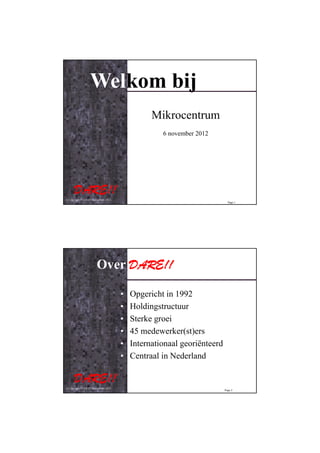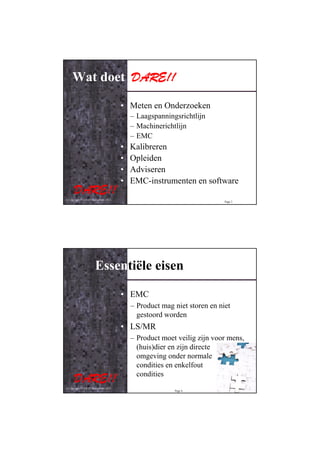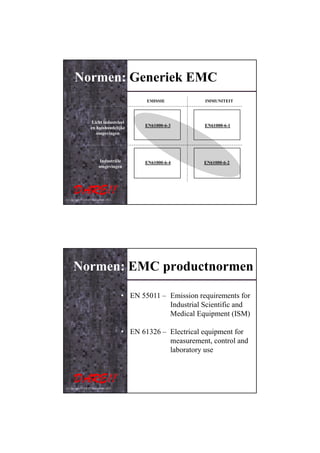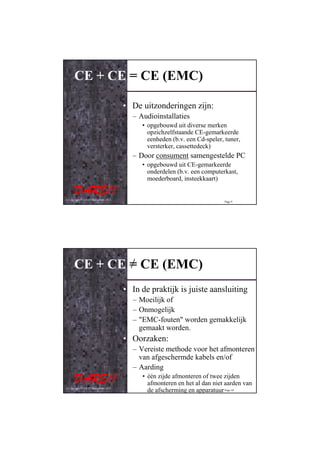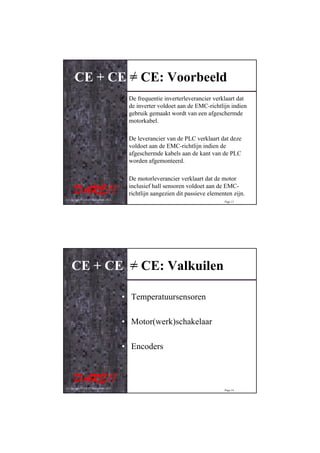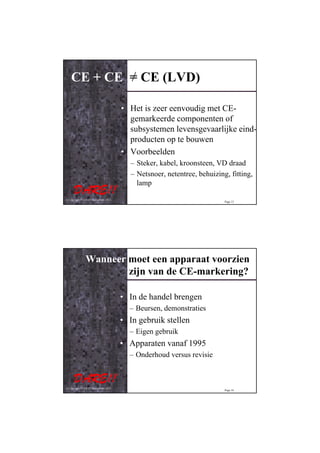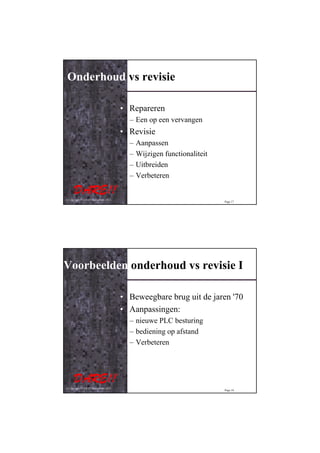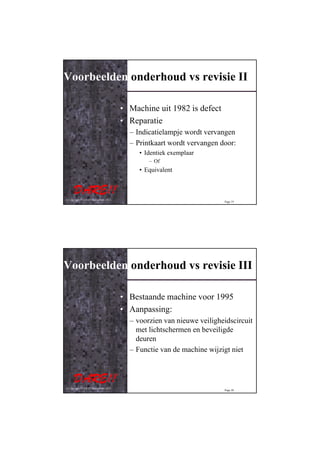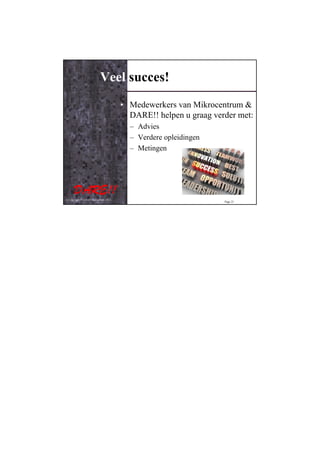Rene Dijkstra - DARE!!
- 1. Welkom bij Mikrocentrum 6 november 2012 ┬® Copyright D.A.R.E!! Instruments 2012 Page 1 Over DARE!! ŌĆó Opgericht in 1992 ŌĆó Holdingstructuur ŌĆó Sterke groei ŌĆó 45 medewerker(st)ers ŌĆó Internationaal geori├½nteerd ŌĆó Centraal in Nederland ┬® Copyright D.A.R.E!! Instruments 2012 Page 2
- 2. Wat doet DARE!! ŌĆó Meten en Onderzoeken ŌĆō Laagspanningsrichtlijn ŌĆō Machinerichtlijn ŌĆō EMC ŌĆó Kalibreren ŌĆó Opleiden ŌĆó Adviseren ŌĆó EMC-instrumenten en software ┬® Copyright D.A.R.E!! Instruments 2012 Page 3 Essenti├½le eisen ŌĆó EMC ŌĆō Product mag niet storen en niet gestoord worden ŌĆó LS/MR ŌĆō Product moet veilig zijn voor mens, (huis)dier en zijn directe omgeving onder normale condities en enkelfout condities ┬® Copyright D.A.R.E!! Instruments 2012 Page 4
- 3. Normen: Generiek EMC EMISSIE IMMUNITEIT Licht industrieel en huishoudelijke EN61000-6-3 EN61000-6-1 omgevingen Industri├½le EN61000-6-4 EN61000-6-2 omgevingen ┬® Copyright D.A.R.E!! Instruments 2012 Normen: EMC productnormen ŌĆó EN 55011 ŌĆō Emission requirements for Industrial Scientific and Medical Equipment (ISM) ŌĆó EN 61326 ŌĆō Electrical equipment for measurement, control and laboratory use ┬® Copyright D.A.R.E!! Instruments 2012
- 4. Normen: Laagspanningsrichtlijn ŌĆó EN 60204 ŌĆō Machines ŌĆó EN 61010 ŌĆō Measurement & Control/lab. ŌĆó EN 60950 ŌĆō Computer apparatuur ŌĆó EN 60335 ŌĆō Commerci├½le machines ┬® Copyright D.A.R.E!! Instruments 2012 *) Richtlijn Medische hulpmiddelen CE + CE = CE (EMC) ŌĆó CE + CE = CE als ŌĆō CE-gemarkeerde onderdelen EN ŌĆō Volgens de installatie-instructie EN ŌĆō Een leek kan geen fouten maken ŌĆó De regel is dus: ŌĆō CE + CE = CE ┬® Copyright D.A.R.E!! Instruments 2012 Page 8
- 5. CE + CE = CE (EMC) ŌĆó De uitzonderingen zijn: ŌĆō Audioinstallaties ŌĆó opgebouwd uit diverse merken opzichzelfstaande CE-gemarkeerde eenheden (b.v. een Cd-speler, tuner, versterker, cassettedeck) ŌĆō Door consument samengestelde PC ŌĆó opgebouwd uit CE-gemarkeerde onderdelen (b.v. een computerkast, moederboard, insteekkaart) ┬® Copyright D.A.R.E!! Instruments 2012 Page 9 CE + CE = CE (EMC) ŌĆó In de praktijk is juiste aansluiting ŌĆō Moeilijk of ŌĆō Onmogelijk ŌĆō "EMC-fouten" worden gemakkelijk gemaakt worden. ŌĆó Oorzaken: ŌĆō Vereiste methode voor het afmonteren van afgeschermde kabels en/of ŌĆō Aarding ŌĆó ├®├®n zijde afmonteren of twee zijden afmonteren en het al dan niet aarden van ┬® Copyright D.A.R.E!! Instruments 2012 de afscherming en apparatuur Page 10
- 6. CE + CE = CE (EMC) ŌĆó In de meeste situaties mag dus niet worden aangenomen dat CE + CE weer CE is ŌĆó Voorbeelden ŌĆō (Speciaal) Machines welke zijn opgebouwd uit (CE-gemarkeerde) motoren, frequentie inverters, PLCŌĆÖs, sensoren etc. ŌĆō Schakelkasten opgebouwd met diverse (CE-gemarkeerde) elektronische componenten. ┬® Copyright D.A.R.E!! Instruments 2012 Page 11 CE + CE = CE Voorbeeld Motorkabel 3~+N+PE Frequentie 400VAC inverter M Hall sensor Besturingskabel 230VAC PLC ┬® Copyright D.A.R.E!! Instruments 2012 Page 12
- 7. CE + CE = CE: Voorbeeld ŌĆó De frequentie inverterleverancier verklaart dat de inverter voldoet aan de EMC-richtlijn indien gebruik gemaakt wordt van een afgeschermde motorkabel. ŌĆó De leverancier van de PLC verklaart dat deze voldoet aan de EMC-richtlijn indien de afgeschermde kabels aan de kant van de PLC worden afgemonteerd. ŌĆó De motorleverancier verklaart dat de motor inclusief hall sensoren voldoet aan de EMC- richtlijn aangezien dit passieve elementen zijn. ┬® Copyright D.A.R.E!! Instruments 2012 Page 13 CE + CE = CE: Valkuilen ŌĆó Temperatuursensoren ŌĆó Motor(werk)schakelaar ŌĆó Encoders ┬® Copyright D.A.R.E!! Instruments 2012 Page 14
- 8. CE + CE = CE (LVD) ŌĆó Het is zeer eenvoudig met CE- gemarkeerde componenten of subsystemen levensgevaarlijke eind- producten op te bouwen ŌĆó Voorbeelden ŌĆō Steker, kabel, kroonsteen, VD draad ŌĆō Netsnoer, netentree, behuizing, fitting, lamp ┬® Copyright D.A.R.E!! Instruments 2012 Page 15 Wanneer moet een apparaat voorzien zijn van de CE-markering? ŌĆó In de handel brengen ŌĆō Beursen, demonstraties ŌĆó In gebruik stellen ŌĆō Eigen gebruik ŌĆó Apparaten vanaf 1995 ŌĆō Onderhoud versus revisie ┬® Copyright D.A.R.E!! Instruments 2012 Page 16
- 9. Onderhoud vs revisie ŌĆó Repareren ŌĆō Een op een vervangen ŌĆó Revisie ŌĆō Aanpassen ŌĆō Wijzigen functionaliteit ŌĆō Uitbreiden ŌĆō Verbeteren ┬® Copyright D.A.R.E!! Instruments 2012 Page 17 Voorbeelden onderhoud vs revisie I ŌĆó Beweegbare brug uit de jaren '70 ŌĆó Aanpassingen: ŌĆō nieuwe PLC besturing ŌĆō bediening op afstand ŌĆō Verbeteren ┬® Copyright D.A.R.E!! Instruments 2012 Page 18
- 10. Voorbeelden onderhoud vs revisie II ŌĆó Machine uit 1982 is defect ŌĆó Reparatie ŌĆō Indicatielampje wordt vervangen ŌĆō Printkaart wordt vervangen door: ŌĆó Identiek exemplaar ŌĆō Of ŌĆó Equivalent ┬® Copyright D.A.R.E!! Instruments 2012 Page 19 Voorbeelden onderhoud vs revisie III ŌĆó Bestaande machine voor 1995 ŌĆó Aanpassing: ŌĆō voorzien van nieuwe veiligheidscircuit met lichtschermen en beveiligde deuren ŌĆō Functie van de machine wijzigt niet ┬® Copyright D.A.R.E!! Instruments 2012 Page 20
- 11. Voorbeelden onderhoud vs revisie IV ŌĆó Productielijn wordt in 2012 opgebouwd uit ŌĆō oude machines ŌĆō nieuwe machines ŌĆō aan elkaar gekoppeld ┬® Copyright D.A.R.E!! Instruments 2012 Page 21 Voorbeelden onderhoud vs revisie V ŌĆó Elektrolyse machine uit de jaren ŌĆÖ90 ŌĆó Voorzien van ŌĆō een nieuwe koelwaterinstallatie ┬® Copyright D.A.R.E!! Instruments 2012 Page 22
- 12. Veel succes! ŌĆó Medewerkers van Mikrocentrum & DARE!! helpen u graag verder met: ŌĆō Advies ŌĆō Verdere opleidingen ŌĆō Metingen ┬® Copyright D.A.R.E!! Instruments 2012 Page 23
